Dominican Anole
| Dominican Anole | |
|---|---|
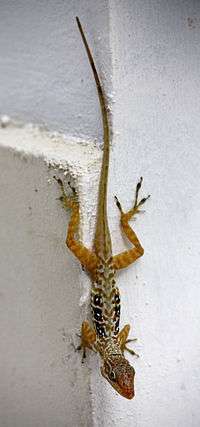 | |
| A male Dominican Anole in its typical perching position. North Caribbean ecotype (A. o. cabritensis). Coulibistrie, Dominica. | |
| Scientific classification | |
| Kingdom: | Animalia |
| Phylum: | Chordata |
| Class: | Reptilia |
| Order: | Squamata |
| Family: | Polychrotidae |
| Genus: | Anolis |
| Species: | A. oculatus |
| Binomial name | |
| Anolis oculatus (Cope, 1879) | |
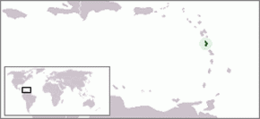 | |
| Endemic to Dominica in the Lesser Antilles, a chain of islands in the Caribbean. | |
| Synonyms | |
|
Anolis alliaceus Cope, 1864 | |
The Dominican Anole or Eyed Anole (Anolis oculatus) is a species of anole lizard. It is endemic to the Caribbean island of Dominica, where it is found in most environments. It is distributed in four main population groups on the island, which were initially described as subspecies and now are recognized as ecotypes. It has a very diverse morphology between these populations, with a ground color that ranges from pale tan or yellow to deep green or brown. It also has patterned markings that range from light-colored speckling to complex marbled patterns, and some populations also have large black-ringed "eye" spots on their flanks. This diversity is the product of adaptation to different ecological conditions found within Dominica, which has made it the subject of numerous studies.
The Dominican Anole spends much of the time in trees but mainly hunts on the ground. Insects make up the bulk of its prey, with soft-bodied invertebrates and small vertebrates hunted less frequently. Long-living and late maturing for anoles, the Dominican Anole can usually breed from around two to three months of age. Females lay eggs, and breeding can occur at any time of year. Clutches number one or sometimes two eggs and are laid under rocks or leaves on the ground. Although presently widespread and common on Dominica, it faces competition from the Puerto Rican Crested Anole, an invasive species which has begun to supplant it in part of its range.
History and taxonomy
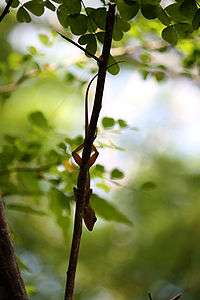
The Dominican Anole is locally known as the zandoli, or tree lizard.[1] The indigenous Caribs considered its presence in their home to be a sign of "good spirits".[2]
American paleontologist and herpetologist Edward Drinker Cope first gave a cursory description of the species, which he named Anolis alliaceus, on the basis of 16 specimens owned by the British Museum that lacked locality data.[3] He later separately described Xiphosurus oculatus in 1879, from 13 specimens in the U.S. National Museum (now the Smithsonian); the name oculatus (Latin, "eyed") refers to its distinctive lateral spots.[4] The two taxa were finally described as one species, Anolis oculatus, in 1888, by the German-British zoologist Albert Günther.[5]
Because of its morphological variation, however, confusion remained as to whether the Dominican Anole comprised multiple species or only one.[6] This was resolved by the work of American herpetologist James D. Lazell, Jr. In 1959, he collected over 500 specimens from thirty localities on Dominica, which he reached primarily on foot or on horseback due to the inadequate road system.[7] From this, he concluded that it was a single species, and in 1962 provided the first coherent account of its variation, organized by different regional populations that he classified as four subspecies: A. o. oculatus, found along the southwestern coastal area, with a holotype from the capital of Roseau (most closely corresponding to the original type described by Cope); A. o. cabritensis, along the northwest coast, with a holotype from the Cabrits peninsula; A. o. montanus, in central, high elevation rain forest, with a holotype from Fresh Water Lake; and A. o. winstoni, along the northeast coast, with a holotype from the village of Woodford Hill.[8] These first descriptions applied only to males, however, and omitted certain morphological features such as scale variation.[9] Lazell returned to Dominica in 1966 to collect new specimens, and in 1972 supplemented his original descriptions, including color illustrations of sexual dimorphism among the types.[10]
Lazell noted that the subspecies he described corresponded with the "strikingly different" ecological zones on Dominica, which result from the extreme elevations on the small island interacting with prevailing winds to produce varying rainfall and vegetation.[11] Later morphological and molecular studies determined, however, that there was no interruption to gene flow between the different populations, but instead clinal variation adaptive to local ecological factors.[12] Researchers have, therefore, determined that there is no basis for the use of subspecies nomenclature.[13] The former subspecies are now described as ecotypes based on their geographic range: the South Caribbean ecotype corresponds to the former A. o. oculatus; North Caribbean ecotype to A. o. cabritensis; Montane ecotype to A. o. montanus; and Atlantic ecotype to A. o. winstoni.[14]
Description

The Dominican Anole is medium-sized for anoles, with a maximum snout-vent-length (SVL) in males of 61–98 mm (2.4–3.9 in) depending on the population (with larger sizes correlating with higher altitudes), and tails of at least equal length; females are smaller in all populations.[15] Adult males have a tail crest and a prominent, extensible throat fan that is often a bright yellow or orange. The throat fan is only rudimentary in females, and less brightly colored. Some populations have bright blue eyes.[16] Like other anoles, Dominican Anoles are capable of slight color change.[17]
Their ground color varies from pale tan or ash gray to deep brown or green. Markings also vary significantly. Adult males in all populations have some combination of white or light-colored spotting distributed over most of their bodies. This manifests in different populations as small, evenly distributed spots; scattered groups of white scales; or streaks that run together in a marbled appearance. Males in some populations additionally have larger lateral spots ringed by irregularly shaped black splotches. Markings on females and juveniles are significantly lighter or less distinct, and black spots are extremely uncommon. Females and juveniles may additionally have lateral streaks or middorsal stripes.
The cause of the Dominican Anole's variability of the Dominican Anole has been the subject of intensive study.[18] Its morphological traits vary independently, such that the presence of one trait does not predict the presence of another. Some traits vary altitudinally and others longitudinally, and correlate with ecological factors such as rainfall and vegetation type.[19] Different traits coincide, however, in regional ecotypes. Populations in drier habitats tend to be paler in color with marbled or blotched markings, while those in wetter habitats are deeper green. The same patterns are also seen in the highly variable A. marmoratus on Guadeloupe, a neighboring island group that has a range of habitats comparable to Dominica.[20]
Ecotype descriptions


The North Caribbean ecotype (formerly A. o. cabritensis) is found in the most arid part of Dominica, in low, scrub-like woodland on the northwest, Caribbean coast. It has the most complex markings of any population, with bold, light-colored spots that run together to form irregular stripes or marbling. Males commonly have a series of prominent, lateral black splotches. Its ground color is predominantly gray or pale yellow brown, sometimes with a darker, occasionally reddish head region.
The South Caribbean ecotype (A. o. oculatus) is found on the south and southwest coast, which does not differ significantly from the north. It is the smallest in size and the palest in color and markings. It has a light tan to yellow ground color, with varying white spots that are typically indistinct. Lateral dark splotches are inconspicuous or absent. This ecotype is threatened by an invasive species (see Conservation).
The Montane ecotype (A. o. montanus) is found in high elevation rain forest located in central Dominica. It has a deep green ground color, which matches the moss-covered tree trunks on which they are mostly found.[21] They have small, bluish-white secondary spots, and occasional lateral, black-ringed splotches on males like those found in the North Caribbean ecotype. The largest sizes are attained among this population.
The Atlantic ecotype (A. o. winstoni) is found along most of the Atlantic (east) coast of Dominica, which is wetter than the west coast. It is intermediate in size, and has a typically orange to chocolate brown ground color, with small, scattered white spots, like the Montane type.
Distribution and habitat
The Dominican Anole is restricted to the island of Dominica, one of the few islands in the Lesser Antilles to have retained its original reptile and amphibian fauna over the last 200 years.[22] It is one of two lizard species endemic to Dominica, the other being the Dominican Ground Lizard.[23] It is the only native anole species on Dominica.[24] It is present in all habitats and areas of the island up to around 900 m elevation and is generally abundant, though it is tending towards extirpation from the southwestern coastal region due to an invasive anole species (see Conservation).[25] The coastal woodlands of Dominica have been particularly noted as unusually favorable for reptiles, with a biomass among the highest recorded for terrestrial reptile populations; Dominican Anoles have been estimated to occur in that environment at a mean density of 2148 per hectare.[26]
Ecology
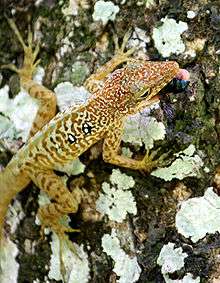
Dominican Anoles are semi-arboreal, and mainly forage on the ground for food.[27] Its diet mainly consists of insects, but varies by habitat and season based on the available food, and with the size of the individual.[28] It may also eat fruit and even small vertebrates.[29] In xeric woodland habitats on Dominica's Caribbean coast, it mainly feeds on tiny ants, termites, springtails, and barklice.[30] Montane populations, which reach larger sizes, rely more on larger and more soft-bodied food such as Oligochaeta and Orthoptera, although smaller adults and juveniles in rain forest environments will also mainly feed on ants.[31]
The main predators of Dominican Anoles are the Antilles Racer, and birds including the Mangrove Cuckoo, thrashers, and kingbirds, all of which are mainly found in coastal regions.[32]
Behavior
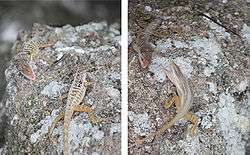
Both males and females are territorial. Male territories are roughly twice the size of female territories, and males will typically mate with females with overlapping territory.[33] Female territories may overlap in areas with high population densities.[34] Research has shown gene flow within the species to be determined by male migration, which suggests that females do not have significant mate choice preferences.[35] Migration probably occurs during the juvenile stage, as male and female adults are mostly sedentary.[36]
During active periods, Dominican Anoles typically perch on a tree or other vertical object, facing downwards to scan the ground for food or other lizards, though this perch makes them vulnerable to predators.[37] From this perch, males will extend and retract their brightly colored throat fans, both to attract mates and to ward off competitors.[38] Males will also bob their heads or perform what look like "push-ups" using their front legs. An invading male may cause a confrontation, during which they will circle at close quarters, inflating their bodies and gaping their mouths to appear larger and menacing. Physical contact during these confrontations is unusual and brief when it occurs, rarely resulting in physical injury. The invader will usually retreat after these confrontations even if it is larger than the defending male.
Activity patterns vary between populations, though the species as a whole is generally most active during the cooler hours of the day.[39] In xeric woodland on Dominica's west coast, it is active throughout the day with peaks at dawn and dusk, while in rain forest populations, it is typically inactive during the middle of the day, remaining at high perches.[40] At night, the Dominican Anole climbs to the tips of branches and sleeps clinging to leaves, where heavier nocturnal predators cannot reach them.[41]
Dominican Anoles in some populations are very tolerant of humans, allowing them to approach closely before retreating.[42] It will seek shelter under stones or other ground litter.[43]
Life cycle and reproduction
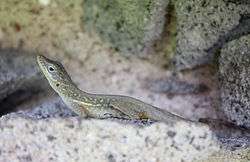
Dominican Anoles are relatively long-living and late maturing compared to mainland anole species.[44] Males mature at a size of 35 mm SVL, and females mature at 40 mm SVL, which they are likely to attain at an age of two or three months old.[45] They breed throughout the year, with a peak at the end of the dry season, particularly in areas such as the north Caribbean coast that have more seasonal rainfall variation.[46] Females are oviparous, and lay multiple clutches of eggs each year, with a short period between clutches.[47] Females in captivity have produced eggs every 14 days.[48] Each clutch typically contains only one egg, though clutches of two can occur without apparent relationship to season, location, or size of the females.[49] Egg production alternates ovaries and overlaps cycles, with one ovary ending its cycle after the opposite ovary has begun.[50] Eggs are laid sheltered under ground litter such as rocks or leaves.[48]
Evolutionary relationships
Anoles in the Caribbean have been extensively studied as "one of the best known cases of adaptive radiation."[51] The Dominican Anole is considered part of the bimaculatus series of Caribbean anoles, which are found on Dominica and islands to its north in the Lesser Antilles, and are more closely related to other Caribbean anoles than to South American anoles.[52] Lazell considered the Dominican Anole "the most bizarre member of the bimaculatus group, and one of the most peculiar members of its huge and diverse genus."[53] Its karotype is unique among that group, as it possesses two pairs of acrocentric macrochromosomes.[54] On this basis, Lazell hypothesized that it "long evolved in isolation, and lacks genuinely close relatives."[55]
Within the bimaculatus series, it belongs to the Guadeloupean-Dominican clade, which includes A. marmoratus on the Guadeloupe Archipelago, A. lividus on Montserrat, A. nubilus on Redonda, and A. sabanus on Saba.[56] A. marmoratus terraealtae, found only on the island of Les Saintes located in between Dominica and the main islands of Guadeloupe, may be more closely related to the Dominican Anole than to other A. marmoratus subspecies.[57] A. leachi, found on Antigua and Barbuda, is a likely sister taxon to the Guadeloupean-Dominican clade.[58] The Dominican Anole is estimated to have emerged from this group as a separate species no earlier than 10 million years ago.[59]
Genetics
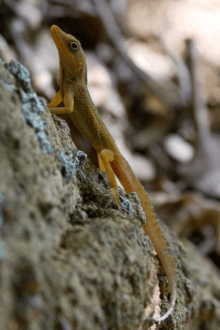
Levels of gene flow are relatively high in Dominican Anole populations over large areas of Dominica, even between different ecotype populations and different members of mitochondrial DNA (mtDNA) lineages.[60] This gene flow appears to be dominated by male migration, and occurs at such high levels as to likely prevent evolutionary divergence of different populations.[35]
Morphological variation between different populations consists of clinal patterns that are incongruent with one another, correlating instead with environmental variables such as rainfall and vegetation type.[61] These patterns of variation are also generally inconsistent with mtDNA lineages.[62] This variation is primarily the result of strong pressures from natural selection caused by differences in habitat, with phenotypic plasticity a possible, though less important, contributing factor.[63]
The populations on the west coast are an exception, and there is a large, apparent barrier to gene flow between the North Caribbean and South Caribbean populations.[64] Though ecological conditions are apparently constant from north to south, there is a transition occurring over just a few kilometers on that coast from the North Caribbean (formerly A. o. cabritensis) ecotype to the South Caribbean (A. o. oculatus) ecotype, with a greater genetic difference between the two populations than would be predicted from their geographic distance.[65] This separation is likely the result of a volcanic event within the last 50,000 years, as the transition zone is marked by relatively recent lava flows.[66]
Conservation
The Dominican Anole is threatened by an invasive competitor, the Puerto Rican Crested Anole, which established itself in Dominica between 1997 and 2002, and has begun to supplant it in the southwestern coastal area surrounding the capital, Roseau.[67] Within that range, the Dominican Anole has become absent or rare.[68] Because that is almost the entire range of the South Caribbean ecotype, researchers have recommended a captive breeding program to preserve genetic diversity.[69] The Dominican Anole may eventually face extirpation from most of Dominica, except for perhaps isolated pockets in rain forest at elevations where the Puerto Rican Crested Anole tends to be restricted to open areas.[70]
See also
Notes
- ↑ Evans & James 1997, p. 20; Crask 2007, p. 20. Also spelled "zanndoli".
- ↑ According to Honychurch.
- ↑ Cope 1864. This history is also recounted in Malhotra & Thorpe 1992, p. 4.
- ↑ Cope 1879.
- ↑ Günther 1888.
- ↑ Garth Underwood wrote in 1959, regarding the widely varying specimens he examined, that "[a]fter two visits to the island and examination of more than sixty preserved specimens I remain uncertain about the situation in Dominica...Clearly Dominica will require further careful examination." Underwood 1959, pp. 204–205.
- ↑ Lazell 1962, p. 466; he recounts the difficulties of his 1959 journeys in Lazell 1972, p. 68.
- ↑ See Malhotra & Thorpe 1992, p. 1 ("Lazell (1962, 1972) was the first to provide a coherent account of the geographic variation in morphology"). Detailed descriptions of the coloration and markings of each described subspecies, along with type specimen data, is provided in Lazell 1962, pp. 467–475, with a Table of Diagnostic Characters at p. 475 cataloging variations in throat fan (dewlap) color, white dorsal spotting, black pigment areas, ground color, venter color, tail crest, and maximum SVL. The SVL figures should be considered inaccurate or incomplete, however, as Lazell later noted that he had incorrectly omitted larger specimens. See Lazell 1972, p. 68.
- ↑ See Lazell 1972, pp. 64–68, describing the errors and inadequacies in his 1962 paper.
- ↑ Lazell 1972, pp. 69–71, 95–96.
- ↑ Stenson, Malhotra & Thorpe 2002, p. 1680; Lazell 1962, p. 474.
- ↑ Stenson, Malhotra & Thorpe 2002, p. 1680; Malhotra et al. 2007, p. 182; Malhotra & Thorpe 1992, p. 4.
- ↑ Malhotra & Thorpe 1992, p. 4 "Consequently, meaningful definition of boundaries between subspecies is difficult".
- ↑ See Malhotra & Thorpe 1992, pp. 3–4 for photographic comparisons of these ecotypes for both males and females.
- ↑ Descriptions are given in Malhotra & Thorpe 1999, pp. 21–24; Malhotra & Thorpe 1992, p. 1; Evans & James 1997, p. 20; Lazell 1962, pp. 466–475; and Lazell 1972, pp. 69–71. See also photographs in Malhotra & Thorpe 1992, pp. 3–4, and color plates in Lazell 1972, pp. 95–96, illustrating male and female variations within and between the different ecotypes. See Malhotra & Thorpe 1997, pp. 68–69, discussing the relationship of male body size to altitude, and noting that size at lower altitudes may be constrained by the higher occurrence of predation in lower coastal areas and by the available food supply.
- ↑ Heselhaus & Schmidt 1996, p. 42.
- ↑ Underwood 1959, p. 204.
- ↑ Malhotra & Thorpe 1999, p. 22.
- ↑ Stenson, Malhotra & Thorpe 2002, p. 1680; Malhotra & Thorpe 1992, p. 4.
- ↑ Malhotra & Thorpe 1999, pp. 75, 77, 81.
- ↑ Malhotra & Thorpe 1999, p. 43.
- ↑ Malhotra et al. 2007, p. 177.
- ↑ Bullock & Evans 1990; Crask 2007, p. 21; Malhotra et al. 2007, p. 182.
- ↑ Malhotra & Thorpe 1992, p. 1.
- ↑ Malhotra et al. 2007, p. 182.
- ↑ Bullock & Evans 1990.
- ↑ Malhotra & Thorpe 2000, p. 246; Malhotra & Thorpe 1999, p. 27; Lazell 1962, p. 467.
- ↑ Malhotra & Thorpe 1999, p. 22; Bullock, Jury & Evans 1993
- ↑ Malhotra & Thorpe 2000, p. 246.
- ↑ Malhotra & Thorpe 1999, p. 27.
- ↑ Malhotra & Thorpe 1999, p. 27; Bullock, Jury & Evans 1993
- ↑ Malhotra & Thorpe 1999, pp. 27–28; Malhotra & Thorpe 1997, p. 68.
- ↑ Stenson, Malhotra & Thorpe 2002, p. 1685; Malhotra & Thorpe 1999, p. 31.
- ↑ Stenson, Malhotra & Thorpe 2002, p. 1685.
- 1 2 Stenson, Malhotra & Thorpe 2002, pp. 1685–1686.
- ↑ Malhotra & Thorpe 2000, p. 255.
- ↑ Malhotra & Thorpe 1999, pp. 27, 31; Lazell 1962, p. 467.
- ↑ A summary description of territorial behavior is in Malhotra & Thorpe 1999, p. 31.
- ↑ Malhotra & Thorpe 1999, pp. 22, 30, 43; Malhotra & Thorpe 1992, p. 4.
- ↑ Malhotra & Thorpe 1999, pp. 30, 43.
- ↑ Malhotra & Thorpe 1997, pp. 30–31.
- ↑ Malhotra & Thorpe 1999, pp. 29–30 (noting that the population at Cabrits National Park is comparatively tame).
- ↑ Lazell 1962, p. 467.
- ↑ Malhotra & Thorpe 1997, p. 68.
- ↑ Somma & Books 1976, pp. 254–255.
- ↑ Malhotra & Thorpe 1999, p. 31; Somma & Books 1976, pp. 251–252, 254.
- ↑ Somma & Books 1976, p. 254.
- 1 2 Malhotra & Thorpe 1999, p. 31.
- ↑ Somma & Books 1976, p. 253.
- ↑ Somma & Books 1976, p. 255.
- ↑ Schneider, Losos & de Queiroz 2001, p. 1.
- ↑ The other major Lesser Antillean group, the roquet series of anoles, is found on Martinique (the island directly south of Dominica) and islands to its south. It is distantly related to the bimaculatus series, having more affinity with South American taxa. See Stenson, Thorpe & Malhotra 2004, p. 2, and Schneider, Losos & de Queiroz 2001, p. 1 for an overview of these groups.
- ↑ Lazell 1972, p. 64.
- ↑ Lazell 1972, p. 71; Schneider, Losos & de Queiroz 2001, p. 8.
- ↑ Lazell 1972, p. 71.
- ↑ See Stenson, Thorpe & Malhotra 2004 and Schneider, Losos & de Queiroz 2001 generally for descriptions and charts of these relationships, and the methodology used. A. nubilus was omitted by Schneider for lack of data; see discussion in Stenson, Thorpe & Malhotra 2004, p. 7.
- ↑ Stenson, Thorpe & Malhotra 2004, p. 7 (urging that it be recognized as a separate species, A. terraealtae); Schneider, Losos & de Queiroz 2001, p. 8.
- ↑ Stenson, Thorpe & Malhotra 2004, p. 6; Schneider, Losos & de Queiroz 2001, pp. 5, 7–8, 10.
- ↑ Malhotra & Thorpe 2000, p. 254.
- ↑ Stenson, Malhotra & Thorpe 2002, p. 1683.
- ↑ Stenson, Malhotra & Thorpe 2002, p. 1680 ("for example, an east-west cline in tail depth and altitudinal clines in scale size and body size").
- ↑ Stenson, Malhotra & Thorpe 2002, p. 1680.
- ↑ See Thorpe, Reardon & Malhotra 2005, generally; Malhotra & Thorpe 2000, p. 246.
- ↑ Stenson, Malhotra & Thorpe 2002, pp. 1683, 1686.
- ↑ Stenson, Malhotra & Thorpe 2002, pp. 1680, 1686.
- ↑ Malhotra & Thorpe 2000, p. 254; Stenson, Malhotra & Thorpe 2002, p. 1686.
- ↑ Malhotra et al. 2007, pp. 182, 187–188. This invasive species is believed to have entered the island via imported goods, as its sites of original invasion are adjacent to a cargo airport and a sea port.
- ↑ Malhotra et al. 2007, p. 178.
- ↑ Malhotra et al. 2007, p. 192.
- ↑ Malhotra et al. 2007, p. 188.
References
- Bullock, D.J.; Evans, Peter G.H. (1990), "The distribution, density and biomass of terrestrial reptiles in Dominica, West Indies", J. Zool. 222 (3): 421–43, doi:10.1111/j.1469-7998.1990.tb04042.x
- Bullock, D.J.; Jury, H.M.; Evans, P.G.H. (1993), "Foraging ecology in the lizard Anolis oculatus (Iguanidae) from Dominica, West Indies", J. Zool. 230 (1): 19–30, doi:10.1111/j.1469-7998.1993.tb02669.x
- Cope, E.D. (1864), "Contributions to the herpetology of tropical America", Proc. Acad. Nat. Sci. Philadelphia 1864: 166–181
- Cope, E.D. (1879), "Eleventh contribution to the herpetology of tropical America", Proc. Ameri. Philos. Soc. 18: 261–77
- Crask, Paul (2007), Dominica, England: Bradt Travel Guides, pp. 20–21, ISBN 1-84162-217-6
- Evans, Peter G.H.; James, Arlington (1997), Dominica, Nature Island of the Caribbean: Wildlife Checklists, Dominica Ministry of Tourism, p. 20
- Günther, A. (1888), "Notes on reptiles and frogs from Dominica, West Indies", Ann. Mag. Nat. Hist., ser. 6 2: 362–366
- Heselhaus, Ralf; Schmidt, Matthias (1996), Caribbean Anoles, New Jersey: TFH Publications
- Honychurch, Lennox, Lennox Honychurch's A-to-Z of Dominica's Heritage, retrieved 2010-01-28
- Lazell, Jr., James D. (1962), "The Anoles of the Eastern Caribbean (Sauria: Iguanidae). Part V. Geographic Differentiation in Anolis oculatus on Dominica", Bull. Mus. Comp. Zool. 127: 466–475
- Lazell, Jr., James D. (1972), "The Anoles (Sauria, Iguanidae) of the Lesser Antilles", Bull. Mus. Comp. Zool. 143 (1): 1–115
- Malhotra, Anita; Thorpe, Roger S. (1992), "Anolis oculatus (Cope): Dominican Anole", Catalogue of American Amphibians and Reptiles 540: 1–4
- Malhotra, Anita; Thorpe, Roger S. (1997), "Size and shape variation in a Lesser Antillean anole, Anolis oculatus (Sauria: Iguanidae) in relation to habitat", Biological Journal of the Linnean Society 60: 53–72, doi:10.1111/j.1095-8312.1997.tb01483.x
- Malhotra, Anita; Thorpe, Roger S. (1999), Reptiles & Amphibians of the Eastern Caribbean, London: Macmillan Education, ISBN 0-333-69141-5
- Malhotra, Anita; Thorpe, Roger S. (2000), "The Dynamics of Natural Selection and Vicariance in the Dominican Anole: Patterns of Within-Island Molecular and Morphological Divergence", Evolution 54 (1): 245–258, doi:10.1554/0014-3820(2000)054[0245:TDONSA]2.0.CO;2
- Thorpe, Roger S.; Reardon, J.T.; Malhotra, Anita (2005), "Common garden and natural selection experiments support ecotypic differentiation in the Dominican anole (Anolis oculatus)", Am. Nat. 165 (5): 495–504, doi:10.1086/428408, PMID 15791540
- Malhotra, Anita; Thorpe, Roger S.; Hypolite, Eric; James, Arlington (2007), "A report on the status of the herpetofauna of the Commonwealth of Dominica, West Indies", Appl. Herpetol. 4 (2): 177–94, doi:10.1163/157075407780681365
- Schneider, Christopher J.; Losos, Jonathan B.; de Queiroz, Kevin (2001), "Evolutionary Relationships of the Anolis bimaculatus Group from the Northern Lesser Antilles", J. Herpetol. 35 (1): 1–12, doi:10.2307/1566016, JSTOR 1566016
- Stenson, Andrew G.; Malhotra, Anita; Thorpe, Roger S. (2002), "Population differentiation and nuclear gene flow in the Dominican anole (Anolis oculatus)", Molecular Ecology 11 (9): 1679–1688, doi:10.1046/j.1365-294X.2002.01564.x
- Stenson, Andrew G.; Thorpe, Roger S.; Malhotra, Anita (2004), "Evolutionary differentiation of bimaculatus group anoles based on analyses of mtDNA and microsatellite data", Molecular Phylogenetics and Evolution 32 (1): 1–10, doi:10.1016/j.ympev.2003.12.008, PMID 15186792
- Somma, Carolynn A.; Brooks, Garnett R. (1976), "Reproduction in Anolis oculatus, Ameiva fuscata and Mabuya mabouya from Dominica", Copeia 1976 (2): 249–256, doi:10.2307/1443943, JSTOR 1443943
- Underwood, Garth (1959), "The anoles of the eastern Caribbean (Sauria, Iguanidae). Part III. Revisionary notes", Bull. Mus. Comp. Zool. 121: 191–226
External links
 Media related to Anolis oculatus at Wikimedia Commons
Media related to Anolis oculatus at Wikimedia Commons- Anolis oculatus at the Encyclopedia of Life